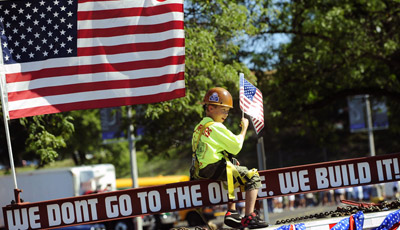
What is the Employee Free Choice Act? Why do we need it? David Madland and Karla Walter explain and fact check conservative claims.

Associate Director, Media Relations

Vice President, Communications

Senior Director, Government Affairs

The freedom to form a union is a democratic right that is under attack. Too many workers are prevented from freely choosing to band together in a union to bargain collectively with their employer on workplace issues.
More than half of all workers in the United States say they would vote to join a union if they could, but union membership in the private sector is less than 8 percent today—down from one-third of private sector workers in the middle of the 20th century—because existing laws make forming a union a Herculean task that few want to undertake.
The Employee Free Choice Act is a sensible reform that would protect workers’ right to join together in unions and make it harder for management to threaten workers seeking to organize a union, but conservatives are waging war against the bill.
The Employee Free Choice Act will restore balance to the union election process by allowing workers the choice to organize a union through a simple majority sign-up process—a system that works well at the small number of workplaces that choose to permit it, raising penalties when the law is violated and promoting productive first contract negotiations with a mediation and arbitration option.
Today, millions of American workers are denied their right to form a union because the process of voting on union formation has been corrupted. Workers that consider forming a union today face an undemocratic system and are frequently intimidated by their employer. A new report by the Center for Economic and Policy Research finds that in 2007 at least one pro-union worker was fired during 30 percent of union election processes, and pro-union activists faced a more than 20 percent chance of being fired.
The problem isn’t just corporations that violate the law. Over the years, our legal system has allowed unfair elections to become the norm. More than 90 percent of companies legally force workers to attend anti-union meetings that include “one-on-one conversations” with supervisors.
According to research by University of Oregon Professor Gordon Lafer, workers often face pressure from their direct supervisors—the person with the most control over their job—to reveal their private preferences for the union. This takes the “secret” out of the “secret ballot”—the most common conservative mischaracterization of current union organizing rules. Meanwhile pro-union employees are banned from talking about forming a union except while they are on break time and from distributing pro-union information except when they are both on break time and in a break room.
Many corporations focus significant time and energy on fighting union organizing drives; 75 percent hire consultants to run sophisticated union-busting campaigns based on mass psychology and distorting the law, according to Cornell University Professor Kate Bronfenbrenner. Corporations can even make dubious "predictions" (but not "threaten") that unionization will force the company to close its doors.
Corporations have the right to their opinion, but they do not have the right to distort the election process to such a degree that it is a parody of democracy. A democratic election requires that one side does not hold all the power, control all the media, and control the timeline of the election. Yet, that is exactly what many union elections look like today.
Nevertheless, there are still workplaces where workers successfully form a union. The corporate response? Often it’s to bargain with the new union in bad faith by using delay tactics and stalling the negotiation of a first contract indefinitely. These delay tactics can cause workers to grow frustrated and lose faith in their ability to be treated fairly at the bargaining table. Only 38 percent of unions certified through the National Labor Relations Board election process achieve a first contract after one year—and only 56 percent ever achieve a first contract.
Unfairly preventing workers from joining together in unions it is not only a violation of their basic human rights, it is also bad for the economy and democracy. Without strong unions, our entire community pays a heavy price: wages lag, race and gender pay gaps widen, and voter turnout is depressed as insecurity, poverty and inequality increase. Income inequality is now at the extreme levels it was in the 1920s, when unionization rates were also below 10 percent.
Unions raise wages and benefits for their members. When unions are strong and able to represent the people who want to join them, these gains spread throughout the economy; non-union companies increase their wages and all workers have more purchasing power, producing a “virtuous circle of prosperity and jobs,” according to University of California at Berkeley Professor Harley Shaiken. Unionized workers also provide a counterbalance on unchecked CEO greed and promote greater income equality. A Center for American Progress report found that strengthening unions is critical to reducing poverty in the United States.
Unions give workers a greater voice at work and in our democracy. On the job, unionized nurses have been able to work with hospitals to improve staffing levels so that patients receive quality care, and firefighters have been able to implement new safety programs to reduce on-the-job fatalities. Unions help people participate in government and significantly increase voting rates, especially for non-white and non-wealthy voters. For every 1 percent increase in union density, voter turnout increases by .2 to .25 percent.[1]
By passing the Employee Free Choice Act, Congress can support workers’ democratic right to bargain for their fair share, raise the wages of working men and women, and pump billions of dollars into the American economy. The bill would allow workers rather than corporations—as under current law—the choice to organize a union through a simple majority sign-up process—a system that works well at the small number of workplaces that choose to permit it. The Employee Free Choice Act would raise penalties when the law is violated, and promote good-faith bargaining through a mediation and arbitration option so that employees can negotiate a first contract.
In 2007, the Employee Free Choice Act passed the House and received majority support in the Senate, but it did not receive enough votes to break the threat of a filibuster. With a new Congress, and President Obama’s promise to sign the bill, the Employee Free Choice Act has a strong chance of becoming law.
For the past few years, some conservatives as well as a host of CEOs have been waging a multi-million dollar campaign to defeat the bill, and they have recently ramped up the intensity of their campaign. Rather than recognize that the freedom to form a union is a democratic right and that we all do better when workers are paid their fair share, opponents are fighting to preserve the status quo. They don’t want their power challenged by unionized workers. When Wal-Mart CEO Lee Scott was asked at an analyst meeting on October 28, 2008 about the Employee Free Choice Act, he stated: "We like driving the car and we’re not going to give the steering wheel to anybody but us."
The campaign against the Employee Free Choice Act often relies on mischaracterization and twisted “facts” that deserve closer scrutiny. Three myths dominate opponents’ arguments against the Employee Free Choice Act, and a closer look shows they’re just not in touch with reality.
FACT: The Employee Free Choice Act restores previously won democratic rights.
FACT: The Employee Free Choice Act promotes free and fair union election processes.
Under this legislation, workers retain the right to choose a traditional election. If at least 30 percent of workers want an election, rather than majority sign-up, a “secret ballot” election will be held.
FACT: The current process is not secret or democratic.
Often, management has already learned where employees stand before the “secret ballot” vote takes place.
The current election process, governed by the National Labor Relations Board, is not democratic and fails on almost every single measure of basic fairness. NLRB elections more closely resemble the sham “elections” of one-party states than anything we would call American democracy.
Firms often prevent workers from even holding an NLRB election.
A new report by the Center for Economic and Policy Research finds that in 2007 corporations fired at least one pro-union worker in 30 percent of NLRB-certified elections, and pro-union activists faced a more than 20 percent chance of being fired.
Every 18 minutes a worker is illegally fired or discriminated against by their employer for their union activity—including discrimination even after a workplace has been organized—yet firms face few consequences when caught.
Unions have long demonstrated their respectful and lawful treatment of workers.
Cornell University Scholar Kate Bronfenbrenner’s exhaustive studies have found that corporate coercion—most of which is legal—is rampant.
FACT: Arbitration encourages negotiations and prevents companies from using delay tactics.
After workers win an election in favor of union representation, a first contract must be negotiated to govern labor management relations. Currently, corporations often engage in bad faith bargaining to prevent recently unionized workers from ever signing a first contract.
The vast majority of contract negotiations are resolved voluntarily where arbitration is an option.
FACT: Industry experts determine agreements based on current practices that are fair to workers and to management.
FACT: Unions are good for all workers. They improve wages, benefits, and working conditions. Even in today’s tough economic times, unions are good for the economy and help foster a competitive high-wage, high-productivity economy.
Unions raise wages and benefits for all workers. Union workers earn significantly more on average than non-union counterparts and union employers are more likely to provide benefits.
Without unions, fewer workers get ahead. Union membership rewards workers for productivity gains they deserve, but do not always receive.
Today, CEOs rather than workers are rewarded for growth in the economy.
Greater unionization will lead to more money circulating in the economy, rather than stagnating in the bank accounts of rich CEOs.
When unions were stronger, the economy thrived.
Small business will continue to thrive under the Employee Free Choice Act.
The freedom to join together in unions is a democratic right – but for American workers this right is under attack. Today union membership rates are low because the current union election process has been corrupted. Workers attempting to organize face an undemocratic process where intimidation is rampant, pro-union voices are silenced, and too often corporations violate workers’ rights. Opponents of the Employee Free Choice Act are fighting to preserve the status quo with a multi-million dollar campaign based on myths and scare tactics. However, by passing the Employee Free Choice Act, Congress can support workers’ democratic right to organize, restore balance to the union election process, raise the wages of working men and women, and pump billions of dollars into the American economy.
For more on the Employee Free Choice Act, see the resource page from the American Worker Project.
[1] Benjamin Radcliff and Patricia Davis, “Labor Organization and Electoral Participation in Industrial Democracies,”American Journal of Political Science, 44 (1) (2000): 132-141.
David Brody, Labor Embattled: History, Power, Rights, (Chicago, University of Illinois Press, 2005).
[3] David Brody, “New strategies: How the Wagner Act became a management tool,” (New Labor Forum, 2004).
[4] Martin Jay Levitt, Confessions of a Union Buster (New York: Crown Publishers, 1993).
[5] HR Policy Association’s review looked for any NLRB decisions involving coercion or deception in connection with a union’s solicitation and collection of union authorization cards. It covered cards signed for union representation purposes. The vast majority of these petitions were most likely petitions for a union representation election.
[6] Julie Martinez Ortega and Erin Johansson, “The Facts Behind the Employee Free Choice Act,” (Washington: American Rights at Work, 2008).
[8] Orley Ashenfelter and Dean Hyslop. “Measuring the effect of arbitration on wage levels: The case of police officers,” Industrial and Labor Relations Review, 54 (2) (2001).
[9] The cost of benefits—especially health insurance—has increased over time and now accounts for a greater share of total compensation than in the past, but this increase is nowhere near enough to account for the discrepancy between wage and productivity growth. For example, according to analysis by the Center for Economic and Policy Research, between 1973 and 2006 the share of labor compensation in the form of benefits rose from 12.6 percent to 19.5 percent.
The positions of American Progress, and our policy experts, are independent, and the findings and conclusions presented are those of American Progress alone. A full list of supporters is available here. American Progress would like to acknowledge the many generous supporters who make our work possible.

Senior Fellow; Senior Adviser, American Worker Project

Senior Fellow, Inclusive Economy